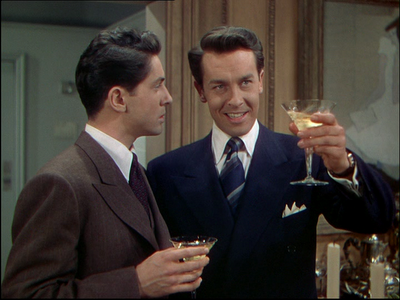Rope
Rope, directed by
Hitchcock came out into the cinemas initially in 1948 and it is about two homosexual
men that live together, through various twists in the plot they are eventually
led to kill their friend because of a deluded self-belief that they are
convinced that he is inferior and they avoid the consequences. After murdering their friend in their apartment,
they put the body into a chest and host a dinner party with the victim’s
friends and family, pretending to show concern. The movie inevitably leads to
the two main characters being discovered by an old lecturer of theirs and
waiting for the authorities to arrive.
Figure1. Champagne
(c1948)
The film uses the camera as a continuous shot rather than
breaking the action into segments, as Croce states: “Rope is shot as a series of long takes, each
editing fissure hidden to create, nearly five decades before Russian Ark, the feeling of a single continuous
shot—where Sokurov's stance posited a historical perspective, Hitchcock's
suggests a moral decision.” (Croce, 2006:2) This illustrates perhaps the
willingness of Hitchcock to shape his film into theatre type production rather
than a movie, as the film is based off a 1929 play. Further, Keyes states “Shot in ten long takes, the movie creates
an elaborate illusion that there is no cutaway or break from the action, as if
to indicate a quiet observer is present in the room for the whole duration of
the story instead of a mere movie camera.” (Keyes, 2014:2) This might
demonstrate that the audience feels like part of the happening, as the film is
also happening in near to real time and views the whole experience through the
eyes of the silent and invisible guest. Perhaps bringing home a heightened
sense of audience participation.
The main characters, Brandon and Phillip, have almost
opposite personalities which create tension right from the beginning, as
Brandon feels confident that they have achieved a “perfect” murder while
Phillip seems closer to just having a mental breakdown, as the consequences of
the deed hang over him, as Schwartz states: “The murder for the thrill of it pleases
Brandon a great deal, as he views his insane act as a work of art; while
Phillip reacts with fright and begins to come apart as the evening wears on.” (Schwartz, 2008:2) The quote suggests that
Brandon is insane and his views on reality are not quite what they should be,
Phillip on the other hand is frail and close to collapsing due to the nature of
the murder, which again underlines the differences in both characters and how
differently they deal with the situation given to them. This tension is perhaps
the main theme of the movie as the two personalities seem to compete in terms
of their own moralities.
Figure 2. Rope
(c1948)
Powerful tools like sound and flashing lights are used very
sparingly but seemingly so for a greater effect, but they are perfectly
integrated into the scene. In the first instance, Phillip plays piano and one
of the guests starts off the metronome while interrogating Phillip about his uneasiness
on that evening, which puts him so on edge that he has trouble playing the
melody but the whole situation relaxes again the instant the metronome is
switched off. In another example, the film is nearly at its end and after the
main characters open the curtains, bright red and green neon lights are
flashing into the sparingly lit room which seems to further increase (or maybe
express) the anxieties Phillip is suffering and also perhaps give Brandon the confirmation
that they have been found out.
Figure 3. Dinner Party
(c1948)
Overall, Rope is a
well-executed film by Hitchcock that, while touching on the moral errors of the
main characters, these tensions are perhaps the main under-lying theme of the
movie, showing the dominance of a warped morality of that of a frightened weaker
one. The movie raises many issues to which many audience members are familiar
with, the issues of right and wrong, of guilt and dominance over another human.
The fear of being punished for our actions and the tension created from
compounding lies.
Illustration List:
Figure 1:
Hitchcock, A. (1948) Champagne [Still].
Available from: https://blogger.googleusercontent.com/img/b/R29vZ2xl/AVvXsEir1Zsc7JNJQBgVPChqX2V5WJtQV7A7reZ1Lf1jt9MQ4iudFa4iho4fITELZ6J3lK38garaGIxs3ky6hOBzo0QwCjDVrKlssS3okpky4ADXP-dKhU_H-6zsWQfv_yl6SAqP34Gku460o2M/s1600/02.png
(Accessed: 13/1/2015)
Figure 2: Hitchcock,
A. (1948) Rope [Still]. Available
from: https://billsmovieemporium.files.wordpress.com/2013/03/rope.png
(Accessed: 13/1/2015)
Figure 3: Hitchcock,
A. (1948) Dinner Party [Still]. Available
from: http://hitchcockzone.com/files/captures/4302_002428.jpg
(Accessed: 13/1/2015)
Bibliography:
Croce, Fernando. (2006) available from: http://www.slantmagazine.com/film/review/rope
(Accessed: 13/1/2015)
Keyes, David. (2014) available from: http://cinemaphile2010.blogspot.co.uk/2014/02/rope-1948.html
(Accessed: 13/1/2015)
Schwartz, Dennis. (2008) available from: http://homepages.sover.net/~ozus/rope.htm
(Accessed: 13/1/2015)



Good, Mailin... did you also notice how the light outside the window gradually changes from dusk to dark, as a means of 'fooling' the audience that more time has passed?
ReplyDeletePS - nice font :)
Hi Jackie, yes I did notice the light change, but I actually thought that it was a bit slower than it should have been, but I don't know how long the sun takes to set in New York so I don't have any theories about it :p
ReplyDelete